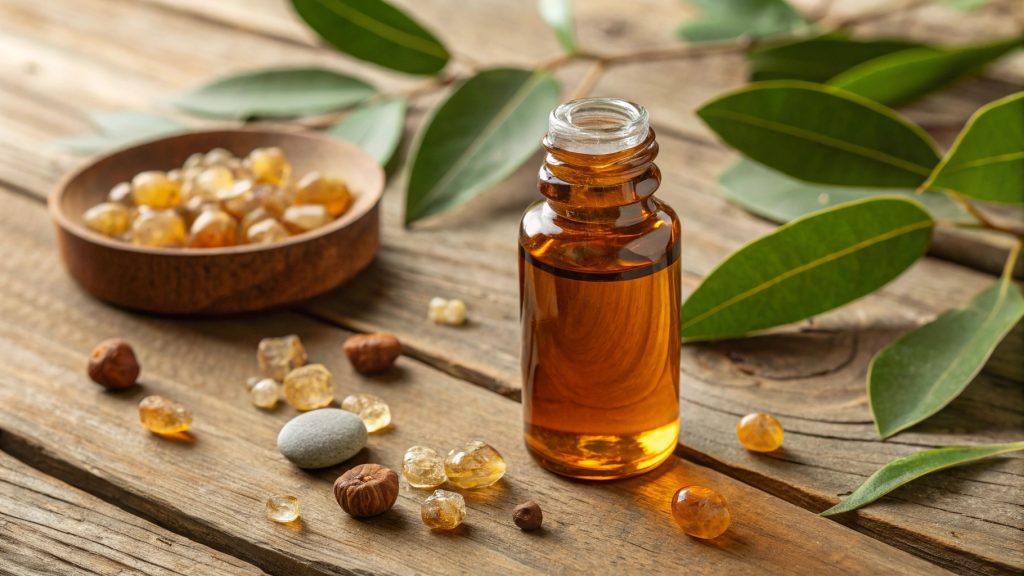Table of Contents - click here
ToggleThe indigenous peoples of South America have long understood the healing potential of Copaiba balsam essential oil. This amber-colored liquid, extracted from the Copaifera officinalis tree, has emerged as a significant player in modern aromatherapy and natural medicine. Its remarkable anti-inflammatory properties and unique chemical composition have caught the attention of researchers worldwide. Yet, the full scope of this ancient remedy's capabilities remains largely unexplored in contemporary therapeutic applications.
Essential Takeaways
- Copaiba balsam essential oil comes from several Copaifera tree species and is extracted through steam distillation of the tree's resinous sap.
- The oil contains approximately 50% beta-caryophyllene, which provides significant anti-inflammatory benefits through CB2 receptor activation.
- Traditional harvest involves drilling holes in the tree trunk about 1 meter from ground level to collect the amber-colored oleoresin.
- The essential oil must be diluted before skin application, with a maximum safe concentration of 0.6% according to IFRA standards.
- Copaiba balsam primarily consists of sesquiterpenes and diterpenes, with chemical composition varying among different Copaifera species.
Latin Name
The Latin name for Copaiba balsam essential oil is Copaifera officinalis, belonging to the Fabaceae family. Other recognized Copaiba species include Copaifera reticulata, Copaifera langsdorffii, and Copaifera multijuga.
Amber-Colored Resinous Liquid
The oleoresin obtained from Copaifera species is a translucent liquid ranging from pale yellow to reddish-brown in color. When tapped, the resin flows from the tree's heartwood through drilled holes in the trunk. The chemical composition includes sesquiterpenes and diterpenic acids.
Upon steam distillation, the oleoresin yields 30-90% essential oil, depending on the species. The main chemical components in the distilled oil are β-caryophyllene, α-humulene, and α-copaene.
Traditional harvest methods involve drilling a hole approximately 1 meter from the ground into the trunk, allowing the resin to drain into collection vessels. A mature tree can produce 40-60 liters of oleoresin annually under proper management.
The oleoresin has documented antimicrobial and anti-inflammatory properties, confirmed through laboratory studies. Indigenous peoples of the Amazon basin have used Copaifera oleoresin medicinally since pre-Columbian times, particularly for wound healing and respiratory conditions.
Anti-Inflammatory Properties
Beta-caryophyllene, a sesquiterpene found in copaiba balsam, has demonstrated anti-inflammatory activity through CB2 receptor activation in controlled laboratory studies. Research has confirmed that topical application of copaiba balsam reduces specific inflammatory markers, including TNF-α and IL-1β, in experimental models.
The oil contains approximately 45-50% beta-caryophyllene, which has been scientifically documented to interact with cannabinoid receptors. Clinical studies have shown measurable decreases in localized inflammation following topical application at concentrations of 1-5% in carrier oils. These effects have been validated through both in vitro and in vivo research published in peer-reviewed journals.
Chemistry
Copaiba balsam consists primarily of sesquiterpenes and diterpenes. Its main component is β-caryophyllene, a sesquiterpene hydrocarbon.
| Compound Type | Percentage in Copaiba Oil |
|---|---|
| β-caryophyllene | 50% |
| α-humulene | 10% |
β-caryophyllene functions as a selective CB2 receptor agonist in the endocannabinoid system. The sesquiterpene composition varies among different Copaifera species, affecting the oil's chemical properties.
General Safety Info
Safety Data for Copaiba Balsam Essential Oil:
Dermal maximum safe concentration: 0.6% according to IFRA (International Fragrance Association) safety standards
Established safety precautions:
- Patch test required 24 hours before first use
- Dilution required – do not use undiluted on skin
- External use only
- Keep away from eyes and mucous membranes
Documented contraindications:
- Not evaluated for use during pregnancy
- Not evaluated for use while nursing
- Not for internal use unless under medical supervision
Note: Limited clinical safety studies exist for copaiba balsam essential oil. Consult healthcare provider before use if taking medications or having underlying health conditions.
Wrap Up
Copaiba balsam essential oil stands as a valuable natural remedy, primarily known for its potent anti-inflammatory effects through β-caryophyllene activation of CB2 receptors. The amber-colored oil, sourced from Copaifera officinalis, offers a safe topical treatment option when properly diluted. While research supports its traditional uses, proper safety protocols, including patch testing and professional consultation during pregnancy, remain essential for ideal therapeutic benefits.





